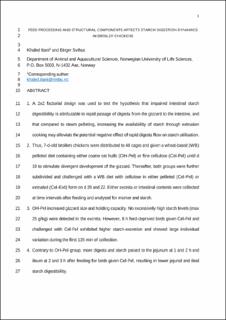| dc.contributor.author | Itani, Khaled | |
| dc.contributor.author | Svihus, Birger | |
| dc.date.accessioned | 2020-10-27T12:51:25Z | |
| dc.date.available | 2020-10-27T12:51:25Z | |
| dc.date.created | 2019-05-03T10:32:24Z | |
| dc.date.issued | 2019 | |
| dc.identifier.citation | British Poultry Science. 2019, 60 (3), 246-255. | en_US |
| dc.identifier.issn | 0007-1668 | |
| dc.identifier.uri | https://hdl.handle.net/11250/2685278 | |
| dc.description.abstract | 1. A 2 × 2 factorial design was used to test the hypothesis that impaired intestinal starch digestibility
is attributable to rapid passage of digesta from the gizzard to the intestine, and that, compared to
steam pelleting, increasing the availability of starch through extrusion cooking may alleviate the
potential negative effect of rapid digesta flow on starch utilisation.
2. Thus, 7-d-old-broiler chickens were distributed to 48 cages and given a wheat-based (WB)
pelleted diet containing either coarse oat hulls (OH-Pel) or fine cellulose (Cel-Pel) until d 19 to
stimulate divergent development of the gizzard. Thereafter, both groups were further subdivided
and challenged with a WB diet containing cellulose in either pelleted (Cel-Pel) or extruded (Cel-Ext)
form on d 20 and 22. Either excreta or intestinal contents were collected at time intervals after
feeding and analysed for marker and starch.
3. OH-Pel increased gizzard size and holding capacity. No excessively high starch levels (maximum
25 g/kg) were detected in the excreta. However, 8 h feed-deprived birds given Cel-Pel and
challenged with Cel-Pel exhibited higher starch excretion and showed large individual variation
during the first 135 min of collection.
4. Contrary to the OH-Pel group, more digesta and starch passed to the jejunum at 1 and 2 h and
ileum at 2 and 3 h after feeding for birds given Cel-Pel, resulting in lower jejunal and ileal starch
digestibility.
5. Increased starch gelatinisation through extrusion processing significantly improved starch digestibility regardless of gizzard function. However, at 1, 2 and 3 h after feeding, more digesta was
retained in the foregut of birds given Cel-Ext.
6. The current data showed that starch degradation rate is associated with the flow of digesta which
is linked to gizzard development, and that enzymatic hydrolysis of intact starch granules may be
limited with more rapid feed passage through the gut. | en_US |
| dc.language.iso | eng | en_US |
| dc.rights | Attribution-NonCommercial-NoDerivatives 4.0 Internasjonal | * |
| dc.rights.uri | http://creativecommons.org/licenses/by-nc-nd/4.0/deed.no | * |
| dc.title | Feed processing and structural components affect starch digestion dynamics in broiler chickens | en_US |
| dc.type | Peer reviewed | en_US |
| dc.type | Journal article | en_US |
| dc.description.version | acceptedVersion | en_US |
| dc.source.pagenumber | 246-255 | en_US |
| dc.source.volume | 60 | en_US |
| dc.source.journal | British Poultry Science | en_US |
| dc.source.issue | 3 | en_US |
| dc.identifier.doi | 10.1080/00071668.2018.1556388 | |
| dc.identifier.cristin | 1695347 | |
| dc.relation.project | Norges forskningsråd: 233685 | en_US |
| cristin.unitcode | 192,10,1,0 | |
| cristin.unitname | Institutt for husdyr- og akvakulturvitenskap | |
| cristin.ispublished | true | |
| cristin.fulltext | postprint | |
| cristin.qualitycode | 1 | |

